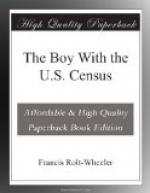[Illustration: TABULATING MACHINE. Mechanism whereby the punched cards are verified and every error prevented, and which also tabulates and numbers all records taken. (Courtesy of the Bureau of the Census.)]
“It does,” the other replied. “Now if you look into those holes in the plate you can see a little cup of bright metal under each hole. What do you suppose that is?”
“I’m not sure, of course,” the boy responded, “but it looks very much like quicksilver.”
“That’s exactly what it is, quicksilver, or mercury. Now mercury, you ought to know, can transmit an electric current, so that if an electrically charged pin comes down into the cup of mercury, the cup itself being attached to an electric current, a circuit is formed.”
“Now I’m beginning to see,” the boy said, “but what is the idea of the cup of mercury; could not the pin just as well touch on a metal plate?”
“It could, of course, but a piece of dust between would prevent contact, the pins would wear away quickly, and the plate would get worn, whereas, by the pin just dropping into the mercury there is no friction and no fear of a missed contact.”
“The pins are in that square box at the end of the long arm which comes down every time a card is put on the plate, aren’t they, Mr. Cullern?” asked Hamilton.
“Yes, and if there is no card there and the pins in the square box are started down, they are automatically stopped before they reach the mercury so as not to make a contact on every point. Also if a card were there without any holes punched, none of the pins would reach the mercury and no contact would be made.”
“But with a punched census card,” interrupted the boy, eager to show that he understood, “the pins go through the holes in the cards and do not go through where no holes are punched, so that somehow the number of holes in the card is registered. But still, there’s so much difference in the cards that I don’t see how this machine can verify them, can tell which are right and which wrong!”
“There is variety enough,” answered the chief, “for of the hundred million cards punched, no two are exactly the same, they could not be.”
“Couldn’t it happen perhaps that two people of the same age should do the same work, be both married and so forth?” asked the boy interestedly.
“They would have to live in the same district, they would have to be employed the same way, they would have both to be married and have the same number of children and a whole lot more things, and even then—the cards would be different for they would represent different numbers on the schedule on which their names were registered. No, there are not two cards in the entire series punched alike.”
“Then I don’t see how in the wide world this machine can tell which cards are right among millions so entirely different from each other.”
“They don’t verify by finding the cards that are right,” was the answer, “but by picking out the cards that are wrong.”




